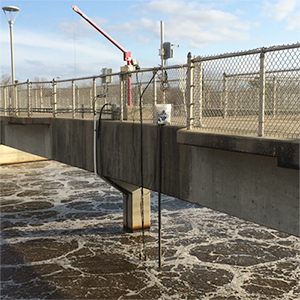Optical Dissolved Oxygen Monitoring Makes Aeration Control Optimization Possible
Problem:
Missoula WWTF operations staff could not count on their 10-year old dissolved oxygen (DO) probes. Whenever there was a problem with the activated sludge aeration control system “The first thing we would do is check the DO probes; clean them, calibrate them and then wait half a day,” according to Gene Connell, treatment supervisor.
“We were spending four hours per week just maintaining the DO probes,” Gene adds.
Solution:
Missoula sought to achieve more reliable measurements and lower maintenance with modern optical DO  technology. There are a lot of choices when it comes to wastewater process DO probes and the Missoula WWTF evaluated a couple of brands before they settled on the FDO sensor from YSI.
technology. There are a lot of choices when it comes to wastewater process DO probes and the Missoula WWTF evaluated a couple of brands before they settled on the FDO sensor from YSI.
Missoula staff was confident in the YSI brand but one of the deciding factors was the innovative configuration of the IQ SensorNet system 2020 XT which allowed them to network all 20 DO probes together on the same controller, reducing hardware requirements and simplifying installation.
Each of the monitoring locations is linked together with a single 2-conductor cable which conveys both power and communications throughout the network. A local electrical contractor was hired to install the system. The contractor was very impressed with the YSI system and the ease of installation. The design of the system allows them to estimate installation costs with confidence making YSI their first choice for future projects.
Results:
Maintenance requirements for the DO probes have been reduced to 1 hour per week freeing up Missoula staff to focus on further optimization of the treatment process. Gene calls the new probes a “game-changer”. He adds, “We trust the DO measurement, it is right on.” The DO probes are installed towards the end of each aerated zone to keep the DO at or below the target range. As a result, energy efficiency has improved which has led to substantial cost savings. The total air flow has been reduced and the precision of the DO control system has increased. The staff is pleased with the ability to better control the process.
Additional Blog Posts of Interest:
Wastewater Aeration Control - Energy Cost Savings Examples
What is Affecting Your Dissolved Oxygen Measurements? Part 1 of 4
Wastewater Monitoring & Control Instrumentation | How Does It Work?
Online Nitrate Monitoring with Optical Sensors for Wastewater Process Control | Webinar